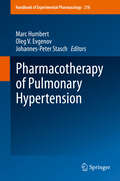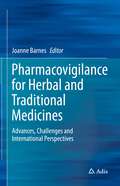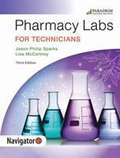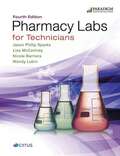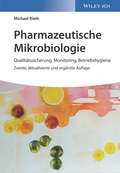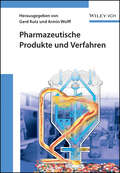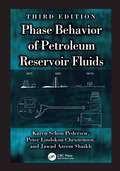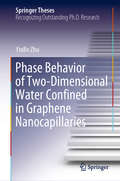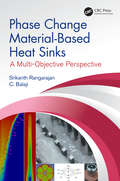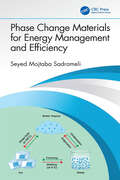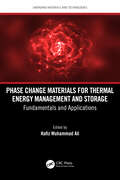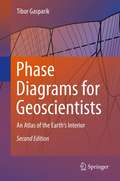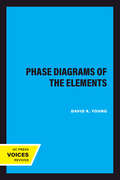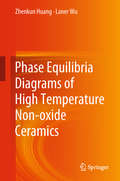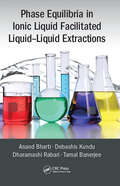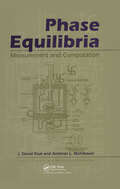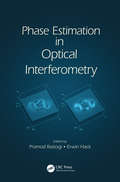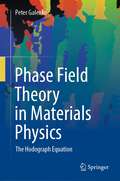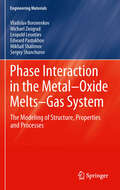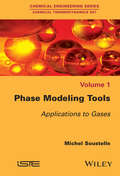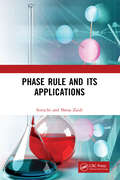- Table View
- List View
Pharmacotherapy of Pulmonary Hypertension (Handbook of Experimental Pharmacology #218)
by Marc Humbert, Oleg V. Evgenov and Johannes-Peter StaschThis volume focuses on current evidence-based pharmacological treatments of various forms of pulmonary hypertension and provides a comprehensive review of the latest developments in this area. The first part of the book covers the definition, classification, pathophysiology, pathology, biomarkers and animal models of the disease, thus laying the conceptual basis for what follows. The middle section provides an overview of the established therapies, such as calcium channel blockers, prostanoids, endothelin receptor antagonists, phosphodiesterase-5 inhibitors and inhaled nitric oxide. The last section explores novel pathways and emerging therapeutic approaches including soluble guanylate cyclase stimulators, Rho-kinase inhibitors, inhibitors of serotonin receptors and transporters, peptide growth factors, vasoactive peptides, modulators of redox equilibrium and cyclic nucleotide homeostasis, as well as immunosuppressive and anti-proliferative agents. Particular attention is given to the clinical applications of these experimental therapies, that are on the horizon. The book thus spans the continuum from basic science to clinical applications.
Pharmacovigilance for Herbal and Traditional Medicines: Advances, Challenges and International Perspectives
by Joanne BarnesThis remarkable new book is the first text dedicated to the topic of pharmacovigilance for herbal and traditional medicines. Taking a truly global perspective, this volume draws together contributions from a diverse group of experts, writing on current knowledge and practices in pharmacovigilance for herbal and traditional medicines, and on advances and innovation in monitoring the safety of this unique and complex category of products and preparations. In part one, the book discusses the current status of pharmacovigilance for herbal and traditional medicines, including the importance of natural products chemistry to harms, and its relevance in considering how pharmacovigilance for these products could be undertaken. Several other chapters discuss methodological approaches and ongoing challenges in pharmacovigilance for herbal and traditional medicines, including issues relating to nomenclature, coding and classification, and the nuances involved in causality assessment. Part two of the book focusses on pharmacovigilance for herbal and traditional medicines around the world, with chapters from authors in several different countries representing diverse historical, ethnic, cultural, social and political contexts. These chapters provide deeper insights and perspectives into spontaneous reporting for herbal and traditional medicines in those countries, and in the context of the local use, practice and regulatory landscape for these products. Part two also provides an overview and new analysis of international case safety reports for herbal medicines held in VigiBase (the World Health Organization's global database of individual case safety reports, maintained by the Uppsala Monitoring Centre).This book is aimed at pharmacists, doctors, nurses and other health professionals, herbal-medicine practitioners and organisations, herbal medicine and pharmaceutical industry personnel, pharmacovigilance specialists, medicines’ regulators, health and social science researchers and academics, pharmacovigilance and health professional students, and students of herbal and traditional medicine, throughout the world. It is an extremely valuable resource for all individuals whose work touches the intersection between herbal medicines and pharmacovigilance, and it provides both an introduction to the topic and a deeper, comprehensive, contemporary account of the topic.
Pharmacy Informatics
by Philip E. Bourne Philip O. Anderson Susan M. McGuinnessApplies the Principles of Informatics to the Pharmacy ProfessionEmphasizes Evidence-Based Practice and Quality Improvement ApproachesLeading the way in the integration of information technology with healthcare, Pharmacy Informatics reflects some of the rapid changes that have developed in the pharmacy profession. Written by educators and profession
Pharmacy Labs For Technicians (Third Edition)
by Jason Philip Sparks Lisa McCartneySuitable for a stand-alone pharmacy lab course or for the lab portion of a pharmacy practice course, Pharmacy Labs for Technicians teaches students detailed lab procedures and skills using hands-on practice.
Pharmacy Labs for Technicians
by Jason Philip Sparks Lisa McCartney Nicole Barriera Wendy LubinPharmacy Labs for Technicians, Second Edition teaches students detailed lab procedures and skills using hands-on practice. Included are 34 labs that teach administrative and clinical procedures such as using pharmacy reference texts, filling prescriptions, compounding medications, and preparing sterile intravenous products.
Pharmacy and Professionalization in the British Empire, 1780–1970 (Medicine and Biomedical Sciences in Modern History)
by Stuart AndersonOffering a valuable resource for medical and other historians, this book explores the processes by which pharmacy in Britain and its colonies separated from medicine and made the transition from trade to profession during the nineteenth and twentieth centuries. When the Pharmaceutical Society of Great Britain was founded in 1841, its founders considered pharmacy to be a branch of medicine. However, the 1852 Pharmacy Act made the exclusion of pharmacists from the medical profession inevitable, and in 1864 the General Medical Council decided that pharmacy legislation was best left to pharmacists themselves. Yet across the Empire, pharmacy struggled to establish itself as an autonomous profession, with doctors in many colonies reluctant to surrender control over pharmacy. In this book the author traces the professionalization of pharmacy by exploring issues including collective action by pharmacists, the role of the state, the passage of legislation, the extension of education, and its separation from medicine. The author considers the extent to which the British model of pharmacy shaped pharmacy in the Empire, exploring the situation in the Divisions of Empire where the 1914 British Pharmacopoeia applied: Canada, the West Indies, the Mediterranean colonies, the colonies in West and South Africa, India and the Eastern colonies, Australia, New Zealand, and the Western Pacific Islands. This insightful and wide-ranging book offers a unique history of British pharmaceutical policy and practice within the colonial world, and provides a firm foundation for further studies in this under-researched aspect of the history of medicine.
Pharmazeutische Mikrobiologie: Qualitätssicherung, Monitoring, Betriebshygiene
by Michael RiethIn seinem Buch zur pharmazeutischen Mikrobiologie geht Michael Rieth, promovierter Mikrobiologe mit langjähriger Erfahrung in mikrobiologischer Qualitätsprüfung in der pharmazeutischen Industrie, auf alle Aspekte dieses für die Pharmaproduktion unentbehrlichen Gebietes ein. Schwerpunkte sind Methoden der Qualitätskontrolle, das Umgebungsmonitoring in der Pharma- und Chemieproduktion sowie die Betriebshygiene. Der Fokus liegt auf bakteriologischen Verfahren einschließlich der mikrobiologischen Schnellmethoden; daneben werden aber auch Zellkulturmethoden und Tiermodelle behandelt. Für die zweite Auflage wurden unter anderem die Themen "Low Endotoxin Recovery" und Maskierung / Demaskierung von Endotoxinen neu aufgenommen. Wo immer möglich, werden die Bezüge zu den neuesten Ausgaben der europäischen und US-amerikanischen Arzneibücher hergestellt.
Pharmazeutische Produkte und Verfahren
by Herausgegeben von Gerd Kutz und Armin WolffA comprehensive overview of the demands on pharmaceutical products and manufacturing processes. It describes in detail the requirements for pharmaceutical production plants, production processes, equipment and machinery, as well as the accompanying qualification and validation measures. Suitable for both engineers in the pharmaceutical industry and in related sectors, as well as for researchers and students in chemical, pharmaceutical, biotechnological and technical courses.
Phase Analysis of Sound Fields: A System-Theoretical Approach
by Mikio TohyamaThis book deals with the phase properties in the context such as sound fields in rooms from a perspective of transfer functions for sound paths. Phase analysis, i.e., investigations of zeros of transfer functions, is a qualitative or system theoretic approach to sound fields rather than the wave-theoretic power spectral analysis. The examination of phase responses offers new insights into sound fields and yields results that the standard power spectral analysis cannot provide. This book presents experimental data and numerical examples based on the mathematical formulations. It shows the mathematical formulations of acoustics and communication systems for engineers and physicists to get familiar with the basics of science. Chapters 1–5 provide the theoretical basis on the system theoretic approach to sound fields where Chapters 1 and 2 are introductions to discrete acoustic systems, Chapters 3–5 summarize wave equations, geometrical and random theories of room acoustics, and Chapters 6–10 develop details of transfer functions in sound.
Phase Behavior of Petroleum Reservoir Fluids
by Karen Schou Pedersen Peter Lindskou Christensen Jawad Azeem ShaikhDeveloped in conjunction with several oil companies using experimental data for real reservoir fluids, Phase Behavior of Petroleum Reservoir Fluids introduces industry standard methods for modeling the phase behavior of petroleum reservoir fluids at different stages in the process. Keeping mathematics to a minimum, this book discusses sampling, characterization, compositional analyses, and equations of state used to simulate various pressure–volume–temperature (PVT) properties of reservoir fluids. The Third Edition has been updated throughout. Reflects advances in equation of state modeling for reservoir fluids and CO2-rich fluids Presents association models along with non-classical mixing rules for handling fluids with aqueous components Has an extended coverage of reservoir fluid communication, energy properties, and asphaltene precipitation Provides practical knowledge essential for achieving optimal design and cost-effective operations in a petroleum processing plant This book offers engineers working in the energy sector a solid understanding of the phase behavior of the various fluids present in a petroleum reservoir.
Phase Behavior of Two-Dimensional Water Confined in Graphene Nanocapillaries (Springer Theses)
by YinBo ZhuIn this book, the authors use molecular dynamics simulations to conduct a comprehensive study of the compression/superheating limit and phase transition of 2D (monolayer, bilayer, and trilayer) water/ice constrained in graphene nanocapillaries. When subjected to nanoscale confinement and under ultrahigh pressure, water and ice behave quite differently than their bulk counterparts, partly because the van der Waals pressure can spark a water-to-ice transformation, known as the metastability limit of two-dimensional (2D) liquids. From a mechanical standpoint, this liquid-to-solid transformation characterizes the compression limit (or metastability limit) of 2D water. The findings presented here could help us to better understand the phase behavior of 2D confined water/ice.
Phase Change Material-Based Heat Sinks: A Multi-Objective Perspective
by Srikanth Rangarajan C. BalajiPhase-change Material based heat sinks and associated optimization remains a topic of great interest, as evident from the increasing number of citations and new applications and miniaturization. Often the multi objective perspective of such heat sinks is ignored. This book introduces the readers to the PCM based heat sinks and Multi objective optimization. The authors have also included interesting in house experimental results on the "Rotating heat sinks" which is a first of a kind work. Useful to budding thermal researchers and practicing engineers in the field, this book is also a great start for students to understand the cooling applications in electronics and an asset to every library in a technical university. Since this book not only gives a critical review of the state of the art but also presents the authors' own results. The book will encourage, motivate and let the reader consider pursuing a research career in electronic cooling technologies.
Phase Change Materials for Energy Management and Efficiency
by Seyed Mojtaba SadrameliThis book explores the prospective applications of Phase Change Materials (PCMs) in energy storage systems, thermal system temperature control, peak shifting, and energy management. It starts with definitions and a brief history of energy storage systems, followed by an exploration of different types of PCMs, encapsulation techniques, heat transfer enhancement methods, and the applications and challenges of PCMs. The book provides a comprehensive overview of PCM applications in building envelopes, free cooling, electrical appliances, lithium-ion batteries, textiles, solar panels, vehicles and logistics, and more across 14 chapters.• Demonstrates various techniques for the enhancement of energy storage systems.• Offers an applied approach.• Discusses energy management, thermal control, peak shifting, energy conservation, and energy storage.Aimed at researchers in industrial manufacturing sectors, it can also serve as a resource for undergraduate and graduate students in energy management courses. In addition, this reference is valuable for engineers and scientists focused on energy optimization and the application of sustainable materials.
Phase Change Materials for Thermal Energy Management and Storage: Fundamentals and Applications (Emerging Materials and Technologies)
by Hafiz Muhammad AliPhase Change Materials for Thermal Energy Management and Storage: Fundamentals and Applications provides the latest advances in thermal energy applications of phase change materials (PCMs). It introduces definitions and offers a brief history, and then delves into preparation techniques, thermophysical properties and heat transfer characteristics with mathematical models, performance-affecting factors, and applications and challenges of PCMs.Features Provides key heat transfer enhancement and thermophysical properties features for a wide range of PCMs. Presents detailed parameter selection procedures impacting heat transfer. Reviews available prediction methods for heat transfer and thermophysical properties of PCMs. Discusses practical applications for enhanced thermal control. Explores challenges and potential opportunities for heat transfer enhancement. This reference offers a comprehensive overview of the fundamentals, technologies, and current and near-future applications of PCMs for thermal energy management and storage for researchers and advanced students in materials, mechanical, and related fields of engineering.
Phase Diagrams for Geoscientists: An Atlas of the Earth's Interior
by Tibor GasparikThe book summarizes the results of the experimental studies of phase relations in the chemical systems relevant to Earth, carried out by the author in a time period of over 20 years between 1979 and 2001. It is based on 1000 piston-cylinder experiments at pressures up to 4 GPa, and close to 700 experiments carried out with a multi-anvil apparatus at pressures up to 24 GPA. This is the largest published collection of calculated phase diagrams for the chemical systems relevant to Earth. This is also the first time that the phase relations at the relatively low pressures of the lithospheric mantle, mainly applicable to the experimental thermobarometry of metamorphic rocks and mantle xenoliths, are seamlessly integrated with the phase relations of the sublithospheric upper mantle and the uppermost lower mantle, primarily applicable to inclusions in diamond and schocked meteorites. "Tibor Gasparik has devoted his career to determining the high-pressure, high-temperature phase relations of the geologically important Sodium-Calcium-Magnesium-Aluminium-Silicon (NCMAS) oxide system. This book is his opus magnum, summarizing more than 1700 experiments in over 120 figures. ... I have found Phase Diagrams for Geoscientists to be a useful first port-of-call for finding the P-T stability fields ... and I can recommend the book as a reference for geoscientists requiring an overview of the stable phase assemblages in the top 700 km of the Earth." (David Dobson, Geological Magazine, Vol. 142 (2), 2005)
Phase Diagrams of the Elements
by David A. YoungThe behavior of solid and liquid matter at high pressures and temperatures is best described in a phase diagram, which shows the regions of stability of different phases of the material. Thanks to the diamond-anvil cell, which has made possible much higher pressures, and to new and very accurate theoretical models and methods, Phase Diagrams of the Elements presents the most up-to-date information on the phase behavior of all the chemical elements from hydrogen to fermium.The book summarizes, with the aid of tables and illustrations, the experimental data and the theoretical calculations. Each element is discussed in a separate section. Other chapters deal with methods, the liquid-vapor transition, and an overview of the elements. While comprehensively reviewing all that has been done in this important area, the author also points to questions that need much more experimental and theoretical work.
Phase Equilibria Diagrams of High Temperature Non-oxide Ceramics
by Zhenkun Huang Laner WuThis book explores new experimental phase diagrams of non-oxide ceramics, with a particular focus on the silicon nitride, silicon carbide and aluminum nitride, as well as the ultra-high temperature ceramic (UHTC) systems. It features more than 80 experimental phase diagrams of these non-oxide ceramics, including three phase diagrams of UHTC systems, constructed by the authors. Physical chemistry data covering the period since the 1970s, collected by the author Z.K.Huang, is presented in six tables in the appendixes. It also includes 301 figures involving about 150 material systems. Most of the phase diagrams have been selected from the ACerS-NIST database with copyright permission. The book methodically presents numerous diagrams previously scattered in various journals and conferences worldwide. Providing extensive experimental data, it is a valuable reference resource on ceramics development and design for academic researchers, R&D engineers and graduate students.
Phase Equilibria in Ionic Liquid Facilitated Liquid-Liquid Extractions
by Anand Bharti Debashis Kundu Dharamashi Rabari Tamal BanerjeeThis book provides a comprehensive overview of ionic liquid based separation techniques. The glimpse of thermodynamic predictive models along with global optimization techniques will help readers understand the separation techniques at molecular and macroscopic levels. Experimental and characterization techniques are coupled with model based predictions so as to provide multicomponent data for the scientific community. The models will focus more on the a-priori based predictions which gives higher emphasis on hydrogen-bonded systems. Particle Swarm Optimization (PSO) technique will also eventually help the readers to apply optimization technique to an extraction process. The overriding goal of this work is to provide pathways for leading engineers and researchers toward a clear understanding and firm grasp of the phase equilibria of Ionic Liquid systems.
Phase Equilibria: Measurement & Computation
by Andreas L. Muhlbauer J. David RaalThis work provides coverage of experimental and theoretical procedures for vapour-liquid equilibria (VLE). A survey of the different models and approaches in recent literature enables the reader to choose the appropriate action.
Phase Estimation in Optical Interferometry
by Pramod Rastogi Erwin HackThis book covers the essentials of phase-stepping algorithms used in interferometry and pseudointerferometric techniques. It presents the basic concepts and mathematics needed for understanding modern phase estimation methods. The book first focuses on phase retrieval from image transforms using a single frame. It then examines the local environment of a fringe pattern, the phase estimation approach based on local polynomial phase modeling, temporal high-resolution phase evaluation methods, and methods of phase unwrapping. It also discusses experimental imperfections liable to adversely influence the accuracy of phase measurements.
Phase Field Theory in Materials Physics: The Hodograph Equation
by Peter GalenkoThis book deals with the use of the hodograph equation in phase transformations in condensed matter, especially, for crystallization and solidification processes. The main focus of the book is the interpretation of the phase-field equations for isotropic and anisotropic interfaces based on the advanced Gibbs–Thomson and Herring conditions, respectively. Beginning with the basic ideas behind the extended irreversible thermodynamics, the kinetic phase-field model for slow and arbitrarily fast phase transformations is derived where the unified hodograph equation follows from:• the sharp interface limit of the diffuse interface or• the traveling wave solution of the propagating phase field.Under the example of solute trapping and disorder trapping effects, comparing theoretical results with molecular dynamics simulations, and with the analysis of experimental data, the concrete workability of the developed hodograph equation is demonstrated for widest range of driving force in phase transformations.
Phase Interaction in the Metal - Oxide Melts - Gas -System
by Mikhail Shalimov Michael Zinigrad Vladislav Boronenkov Edward Pastukhov Leopold Leontiev Sergey ShanchurovThis monograph describes mathematical models that enable prediction of phase compositions for various technological processes, as developed on the base of a complex physico-chemical analysis of reaction. It studies thermodynamics and kinetics of specific stages of complex pyrometallurgical processes involving boron, carbon, sulfur, tungsten, phosphorus, and many more, as well as their exposure to all sorts of factors. First and foremost, this enables to optimize processes and technologies at the stage of design, while traditional empirical means of development of new technologies are basically incapable of providing an optimal solution. Simulation results of metals and alloys production, welding and coating technologies allow obtaining materials with pre-given composition, structure and properties in a cost-saving and conscious manner. Moreover, a so-called "inverse problem", i.e., selecting source materials which would ensure the required results, cannot be solved by any other means.
Phase Mapping of Human Biological Tissues: Data Processing Algorithms for Forensic Time of Death Estimation (SpringerBriefs in Applied Sciences and Technology)
by A. G. Ushenko Yu. A. Ushenko Igor Meglinski Zhengbin Hu Iryna V. Soltys V. T. Bachinsky O. Y. VanchulyakThis book presents numerical computer-aided smart-methods as part of a comprehensive statistical, correlation and fractal analysis of laser polarimetry data. It highlights relationships between polarization (azimuth distributions, polarization ellipticities, Stokes vector parameters, Mueller matrix elements) parameters of laser images of biological tissues of a human corpse in different spectral ranges and temporal dynamics of their postmortem morphological changes. The book discusses the effectiveness of correlation analysis of two-dimensional distributions of polarization inhomogeneous images of histological sections of the main types of biological tissues in determining the time of death. It also discusses the development of basic principles of phase measurements (phasometry) of microscopic images of biological tissues to determine the age of death and the time of hematoma formation. Also presented in the book are possibilities of complex laser spectral photopolarimetry images of histological sections of biological tissues of human corpse in different spectral regions, with the simultaneous development and substantiation of a set of statistical and correlational criteria for objective determination of the time of death.
Phase Modeling Tools
by Michel SoustelleThis book is part of a set of books which offers advanced students successive characterization tool phases, the study of all types of phase (liquid, gas and solid, pure or multi-component), process engineering, chemical and electrochemical equilibria, and the properties of surfaces and phases of small sizes. Macroscopic and microscopic models are in turn covered with a constant correlation between the two scales. Particular attention has been given to the rigor of mathematical developments.
Phase Rule and Its Applications
by Suruchi Sheza ZaidiThe book covers the fundamental concepts of phases, phase diagrams and their applications. Stress is on understanding and not on memorization. The book has descriptive passages and diagrams (cooling curves) that help students gain a solid foundation in subject. This text will help them learn phase rule faster. It also contains numerous phase diagrams. Note: T& F does not sell or distribute the Hardback in India, Pakistan, Nepal, Bhutan, Bangladesh and Sri Lanka.
